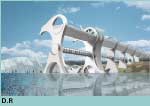 |
Editorial |

 |
Network
news |



 |
Life
on the canals |



|
|

|
|
| |
NETWORK
NEWS

|
The
VEV committees meeting in Milan on 29/10/99 recorded the commitment
of almost the entire budget, widely varying rates of completion
of actions depending on their complexity, but in any event a strong
desire of the partners to pursue their common action on completion
of the Terra programme.
The VEV project monitoring chart, presented in Milan, reveals
an overall rate of progress approaching 50%. While certain projets,
essentially studies, have been completed, others are more complex
to manage and have taken longer to gather pace. The situation
shown on the following pages takes into account the remarks made
and adjustments proposed by the partners during the meeting. The
diversity of projects, which is precisely the wealth of the VEV
partnership, has also suggested a first attempt at modelling the
network in terms of thematic approaches to historic canals, also
establishing links with the processes of design of the European
Spatial Development Perspective (ESDP). The proposed model is
reproduced on page 8. This approach to the "tableau de bord"
is comple-mentary to that of the project sheets. Although the
latter (usually referred to as "fiches") remain the
contractual documents between the partners, the monitoring chart
aims to provide maximum legibility of the entire VEV project,
an objective also underlined by the evaluation team CMA (a consultancy
tied to Linköping University) in its preliminary report,
presented by Frederik Samuelson.
|
 |

The
first chart lists the actions by geographical
region, showing the degree of "transnationality" per action.
The second above distinguishes actions by nature, with the accent
on the way the different actions link with each other, in relation
to the specific issues of historic canals. What is their future
as vehicles for spatial development planning? This is the question
which the partners' actions are trying to address, with somewhat
differing angles depending on the context. The partnership has given
rise to a whole range of reflections and initiatives, which will
pose a serious challenge for the reporters at the closing conference,
responsible for synthetising the conclusions! This is also the conclusion
drawn by the "Terrassistance" team in its overall assessment.
Comparing VEV to the other projects involving river basins, the
draft report underlines the large number of individual projects,
only a minority being specifically transnational in their implementation.
In this context, it is the exchange of experience which will determine
the success of the programme, even if numerous more or less informal
transnational links contributed to the partners' reflection at the
design stage, as underlined by the leading partner during the meeting.
The technical "animateur" also suggested that the delays
incurred on some of the projects could be explained by the need
to forge a genuine cohesion at the trans-national level. In the
VEV network, cohesion can only be attained through a substantial
coordination effort in two languages. The International Centre for
Historic Canals, for its data base on the internet, was thus the
subject of a bilingual specification on which VNF consulted all
the other partners before putting out the call for tenders. The
reaction from British Waterways, presented by their archivist Paul
Sillitoe in late December 1999, is revealing of the partnership
spirit. He warmly welcomed the initiative, at the same time posing
a series of practical questions which have not all been fully resolved
as we go to press. In any event, it is worth noting that this is
an action financed by one partner but deliberately open to the others,
thus revealing a genuine effort to establish a common tool. The
Terrassistance team finishes its report on a positive note: "the
VEV projet found its rhythm thanks to an increasing awareness of
common targets and high added value for all partners involved in
learning from each other's experience; it is thus developing sustainable
output. Well prepared and attended inter- national workshops and
qualitative and well conceived meetings of steering and working
committees on a regular basis with involvement of politicians became
the uniting force of the project."


|
 |
|
|

